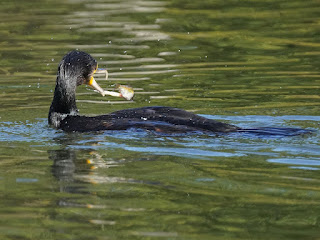This young Lesser Black-Backed Gull is probably the son of Pigeon Eater, who had chased all the other gulls away. He had found a sweetcorn husk. There wasn't much to eat on it but it made a good toy as it could be rolled around, something that young gulls find fascinating.
Several small birds, silhouetted against the sunlight, flew into the top of a hawthorn near Peter Pan. Looking at the picture afterwards I could see that it was a group of Blackcaps, which would have come to eat the ripe berries. This is a male.
A Robin in the bushes near the Henry Moore sculpture insected a spider's web to see if there was anything edible in it.
The female Little Owl at the Serpentine Gallery was dozing in the warm sunshine in her usual lime tree.
It's always feeding time for the ravenous Great Crested Grebe chicks on the Long Water.
The youngest chick on the Serpentine was with its mother under a boat.
A Cormorant caught a carp in the Long Water and tossed it in the air to turn it round.
There's a new young Mute Swan on the Round Pond. Its wings are already developed and it must have flown in from outside the park. It was with a female adult which may have been its mother.
The cygnet that walked to the pond from the main lake is still small and won't be flying for some time.
Belinda Davie got a good picture of the female Tufted Duck with a white face. It's definitely not a Scaup or any kind of hybrid.
There are still lots of Migrant Hawkers, especially between the Serpentine Gallery and the bridge, where I photographed this male perched on a reed stem.
Dragonflies have the sharpest eyes of any insect, with 28,000 to 30,000 ommatidia (cells that give the equivalent of pixels in a photograph) in each one. How sharp is that? This picture has the same resolution as a dragonfly's entire field of vision, 60,000 pixels -- I enlarged it for demonstration. So they're not all that sharp by the standards of a human or a bird.
This isn't a wonderful picture but it's the best I could get of a female Common Darter whizzing up and down to lay her eggs in water at Peter Pan.
The patch of green alkanet at the top of the steps by Temple Gate keeps coming back into flower. It's popular with Common Carder Bees.
Two more Common Carders on a phlomis in the Rose Garden.
Mauve Michaelmas daisies attracted plenty of Honeybees. A smaller bee, probably a Mining Bee, made a brief appearance. Michaelmas is 29 September, not for another 15 days -- I wonder if the flowers will still be blooming.
A Common Drone Fly, Eristalis tenax, browsed on ivy flowers at the back of the Lido.
The large frightening notices all around the lake about toxic blue-green algae have of course been taken down as workmen install the paraphernalia for the swimming event at the weekend. In their place is one modest notice at the Lido, as far away as possible from the event. If anything unfortunate happens the park administration can still say 'I told you so.'








%202023%201a.jpg)







The dragonfly stuff today is amazing. I did not even know that there were common darters in the park and the way you managed to show how a dragonfly sees is amazing!
ReplyDeleteTheodore
DeleteThank you. Common Darters are quite common in the park, and you sometimes see the basking on the edge of the Italian Garden pools, though their season is pretty much over now. In recent years there have also been occasional Scarlet Darters, most spectacular with red wings.
DeleteScarlet Darters are my favourite dragonfly ever! I managed to get my camera within a few millimetres of its face so I got a pretty strange shot!
DeleteTheodore
Cormorants and other fish eating birds have some skills to toss their prey at an angle into the air and catch it head first for swallowing. Cool science on the Dragonfly POV.
ReplyDeleteI don’t understand how the park has the front to warn the public of the dangerous waters and then to advertise them to join in on a swim in it!.. obviously just looking to make a buck and test the peoples stupidity. It’s all in good fun anyway! Until someone turns into radioactive man!
Sean
Wonderfully creative and ingenious analysis of the dragonfly's vision! I suppose they will rely more on the ability to see in the ultraviolet range than on acuity, which a bird would?
ReplyDeleteTinúviel
The colour in that picture, of course, is not what a dragonfly would experience. But the rather low resolution is, and that must be limiting. A dragonfly couldn't tell a bee-mimicking hoverfly from a real bee, while a bird can and does. But I don't know how that works out in practice. After all, dragonflies have been doing very well for hundreds of millions of years.
DeleteSeem to recall that dragonflies have been around since the Carboniferous Period, which gives them a continuous existence of around 240 million years - they have certainly downsized from the Meganeuron, though 😮
DeleteMore than that, maybe more than 320 million years ago, if you count the Meganisoptera which were the first insects to have that design. The layout was so perfect that there was no need to change it.
DeleteLove the shot of the adult and juvenile GCG's 😀
ReplyDeleteUnusual that a chunk of plastic should provide such a pretty background.
DeleteFor sure: especially when we recall that monstrosity of 'art' known as the 'London Mastaba' ;)
DeleteThe Royal Parks aren't the greatest exponent of the King's English with their repeated treatment of "algae" as a singular noun, and printing "in The Serpentine" thus. Jim
ReplyDeleteI think Klingon is their first language.
Delete